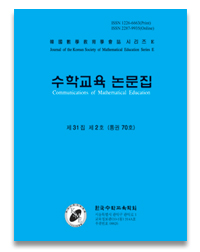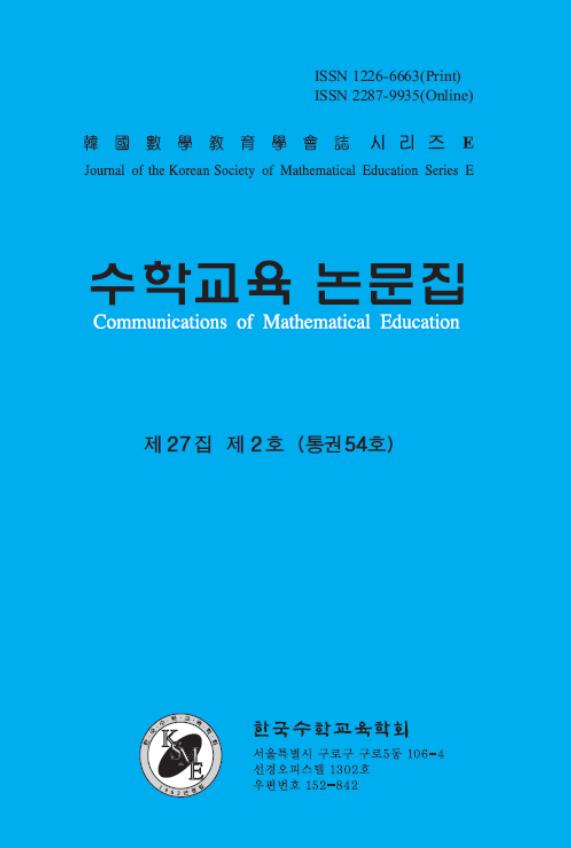|
Designing a teaching unit to foster preservice mathematics teachers’ connectivity competence: Exploring triangle centers and distance optimization
허남구 Heo Nam Gu
39(3) 327-347, 2025
DOI:10.7468/jksmee.2025.39.3.327
허남구 Heo Nam Gu
DOI:10.7468/jksmee.2025.39.3.327 JANT Vol.39(No.3) 327-347, 2025
The purpose of this study is to design a teaching unit titled < Exploring Triangle Centers and Distance Optimization > to foster preservice mathematics teachers’ connectivity competence. To this end, Wittmann’s approach to design science was applied, and the “What if not” strategy proposed by Brown and Walter (2005) was employed to develop exploratory tasks from initial problem situations. Three initial problems were based on Viviani’s Theorem, Clough’s Theorem, and Fermat’s Point. Using the “What if no?” strategy, three corresponding exploratory tasks were developed, each involving the search for a point that minimizes the sum of the squares of distances. The exploratory task developed by applying the “What if not” strategy to Fermat’s Point is associated with the centroid of a triangle, the task based on Clough’s Theorem using the same strategy is also associated with the circumcenter of a triangle, the task based on Viviani’s Theorem using the same strategy is also associated with the symmedian point(Lemoine point) of a triangle. The teaching unit designed in this study is expected to support teachers in developing a deep understanding of triangle centers, enhance their connectivity competence in exploring the relationship between triangle centers and distance optimization, and provide them with experience in applying the “What if not” strategy.
|
|
Analysis of 3rd grade mathematics textbooks on 'Estimation with Natural Numbers' under the 2022 revised curriculum: Focusing on units of addition, subtraction, and multiplication
김민경 Kim Min Kyeong , 주영은 Joo Yeong Eun , 정혜인 Jeong Hye In , 김미진 Kim Mi Jin
39(3) 349-372, 2025
DOI:10.7468/jksmee.2025.39.3.349
김민경 Kim Min Kyeong , 주영은 Joo Yeong Eun , 정혜인 Jeong Hye In , 김미진 Kim Mi Jin
DOI:10.7468/jksmee.2025.39.3.349 JANT Vol.39(No.3) 349-372, 2025
This study analyzed how the estimation is implemented in the ‘Addition and Subtraction’ and ‘Multiplication’ units of third-grade elementary mathematics textbooks developed under the 2022 revised mathematics curriculum. To this end, nine authorized textbooks were examined in terms of the frequency of estimation, the strategies applied, and whether estimation was addressed in independent lessons. Among them, four textbooks that provided estimation as an independent lesson were further analyzed to investigate how the estimation was presented. The analysis revealed that in most of the nine textbooks, estimation was introduced only as a supplementary concept, and estimation strategies were used in a limited manner. These findings suggest the necessity of providing more in-depth instruction, in which students learn various estimation strategies through independent lessons and apply them to real-life problem situations, thereby adjusting their estimates and evaluating the reasonableness of the results. Furthermore, the study is expected to serve as foundational teaching and learning material for future textbook development, enabling students to cultivate flexible and strategic estimation skills.
|
|
Developing and implementing a DAITC curriculum for pre-service mathematics teachers
김원 Kim Won
39(3) 373-400, 2025
DOI:10.7468/jksmee.2025.39.3.373
김원 Kim Won
DOI:10.7468/jksmee.2025.39.3.373 JANT Vol.39(No.3) 373-400, 2025
This study developed a teacher-education curriculum to enhance pre-service mathematics teachers’ Digital-AI Integrated Teaching Competency (DAITC) and examined changes in their perceptions. The 16-week curriculum was implemented with 41 undergraduates majoring in mathematics education at a college of education in Seoul. A mixed-methods design was employed: quantitatively, DAITC pre- and post-surveys were analyzed using paired-samples t-tests; qualitatively, reflective journals were analyzed via directed content analysis. Findings were as follows. First, participants perceived the necessity of DAITC higher than their current performance, and the difference was statistically significant. Second, after the curriculum, all DAITC domains―foundational, design/implementation, and assessment― showed statistically significant improvement. Third, qualitative results confirmed a pedagogical reappraisal of technological tools and substantive strengthening of lesson design, implementation, and evaluation competencies. Fourth, positive changes also emerged in affective domains, including recognition of technology’s educational usefulness, self-efficacy, positive attitudes, professional responsibility, and willingness for continuous professional development. Overall, the curriculum substantively enhanced DAITC among pre-service mathematics teachers and provides empirical guidance for research on teacher professionalism and for teacher-education policy in the AI era.
|
|
Development of an artificial intelligence convergence education program to enhance mathematics teachers’ competencies in guiding STEM career pathways
안서현 Ahn Seo Hyun
39(3) 401-429, 2025
DOI:10.7468/jksmee.2025.39.3.401
안서현 Ahn Seo Hyun
DOI:10.7468/jksmee.2025.39.3.401 JANT Vol.39(No.3) 401-429, 2025
This study aims to develop a mathematics and artificial intelligence (AI)-Convergence education program to enhance the STEM career guidance competency of high school mathematics teachers and to analyze the results of its implementation. The program was developed based on the procedures of the ADDIE model and comprised six instructional domains: provision of STEM career information, self-understanding guidance, mathematics curriculum-linked career lessons, understanding AI-Convergence education, understanding mathematics-based AI, and designing mathematics -career-AI Convergence lessons. It incorporated Huber’s (2004) eight-step Forschendes Lernen (inqury-based learning) inquiry cycle. The program was designed to strengthen teachers’ inquiry competence beyond mere knowledge acquisition, enabling them to act as ‘practitioner-researchers.’ The implementation results showed significant improvements in lesson design competency, career guidance competency, and inquiry-based teaching practice, along with positive feedback from participants. This study presents the characteristics of the program, the applicability and limitations of the Forschendes Lernen-based design, and the importance of strengthening teachers’ career guidance competency.
|
|
A discussion on the mathematical disturbance revealed in the exploration of the cross-section of a cylinder
김원영 Kim Wonyeong , 신보미 Shin Bomi , 김연수 Kim Yeansu
39(3) 431-457, 2025
DOI:10.7468/jksmee.2025.39.3.431
김원영 Kim Wonyeong , 신보미 Shin Bomi , 김연수 Kim Yeansu
DOI:10.7468/jksmee.2025.39.3.431 JANT Vol.39(No.3) 431-457, 2025
This study focuses on a textbook problem to explore the connection between conic sections and quadratic curves, and to examine the implications of disturbance in mathematics education. The researcher’s initial disturbance, triggered by the statement that the cross-section of a cylinder cut by an inclined plane is an ellipse as well as a related student’s question, led to the formation of two research questions. The first investigates various approaches to explaining why the resulting cross-section is an ellipse, which led to the design of a task examining how the cross-section varies as the slope of the cutting plane changes. The second explores how high-achieving students responded to this task, analyzing mathematical disturbances they experienced and revealing a variety of concept images related to ellipses. These findings suggest that such moments of disturbance can act as productive drivers of learning, highlighting the need for instructional designs that recognize and pedagogically utilize these opportunities. Moreover, this study can serve as a foundation for strengthening the connection between conic sections and quadratic curves in classroom learning.
|
|
A macroscopic-metacognitive analysis of the learning sequence of geometry terms in elementary school students
강윤지 Kang Yunji
39(3) 459-473, 2025
DOI:10.7468/jksmee.2025.39.3.459
강윤지 Kang Yunji
DOI:10.7468/jksmee.2025.39.3.459 JANT Vol.39(No.3) 459-473, 2025
This study explores the cognitive structures of elementary school students by analyzing how they arrange geometry terms, viewing this process as an outcome of macroscopic-metacognitive activities where learners organize and hierarchize their own knowledge. For this purpose, 37 upper-grade elementary students were asked to freely arrange 16 key geometry terms. The tendencies in their arrangement order were then analyzed and compared with the sequence presented in elementary math textbooks. The results revealed a clear tendency in the aggregate data, where students collectively prioritized relational concepts over most shape-related concepts in their average rankings. Furthermore, students demonstrated a complex method of knowledge reconstruction, organizing concepts based on perceived cognitive complexity rather than the pedagogical path of the textbook. In conclusion, this study confirmed that the geometry term arrangement task is a useful diagnostic tool for identifying students’ inherent cognitive structures, and suggesting the necessity of developing assessment methods and instructional strategies that take into account students’ internal logic.
|
|
A study on undergraduate students’ understanding of the concept of matrix rank
오윤정 Oh Yunjeong , 정근영 Jeong Keunyoung
39(3) 475-493, 2025
DOI:10.7468/jksmee.2025.39.3.475
오윤정 Oh Yunjeong , 정근영 Jeong Keunyoung
DOI:10.7468/jksmee.2025.39.3.475 JANT Vol.39(No.3) 475-493, 2025
The rank of a matrix is one of the key concepts in linear algebra, closely connected to other fundamental concepts. However, this interdependence leads to major difficulties for undergraduate students. This study qualitatively analyzes undergraduate students’ learning processes from the perspective of APOS theory, proposes a genetic decomposition of the concept of rank, and describes misconceptions, errors, and difficulties regarding the concept. From the genetic decomposition, we observed that students tend to construct an instrumental understanding of rank by identifying it with the number of leading entries in the row reduced echelon form, rather than with the dimension of the column space. Such misconceptions are manifested in students’ difficulties in representing the column space as a vector space, and in their incorrect use of the row reduced echelon form when finding a basis of the column space. Therefore, it implies that students need to integrate the vector space schema and the basis schema to attain an essential understanding of the rank of a matrix. These results also offer suggestions for instruction in linear algebra, particularly regarding the concept of rank.
|
|
A longitudinal and cross-national analysis of financial literacy in the elementary mathematics curriculum
최단비 Choi Danbi , 장혜원 Chang Hyewon
39(3) 495-516, 2025
DOI:10.7468/jksmee.2025.39.3.495
최단비 Choi Danbi , 장혜원 Chang Hyewon
DOI:10.7468/jksmee.2025.39.3.495 JANT Vol.39(No.3) 495-516, 2025
This study examines the presence of economic and financial education in the Korean elementary mathematics curriculum through a longitudinal analysis from the 1st National Curriculum to the 2022 Revised Curriculum, and a cross-national comparison with the curricula of Australia, England, Singapore, and Canada. Financial literacy is a core competency enabling individuals to make informed financial decisions based on knowledge, skills, and confidence, and its early introduction at the elementary level has been widely emphasized. The analysis compared the inclusion of basic (e.g., currency units, calculations) and extended elements (e.g., budgeting, saving, consumption, investment) of financial literacy, and further examined instructional content across four categories: numerical understanding of money, transactions and calculations, budgeting and financial planning, and financial decision-making. Findings indicate that while the four countries systematically integrate financial literacy into their mathematics curricula, Korea’s 2022 Revised Curriculum lacks explicit components, limiting opportunities for practical learning. Based on these results, this study highlights the need to structurally integrate financial literacy into Korea’s elementary mathematics curriculum to better prepare students for real-life financial contexts.
|

 Communications of Mathematical Education
Communications of Mathematical Education

